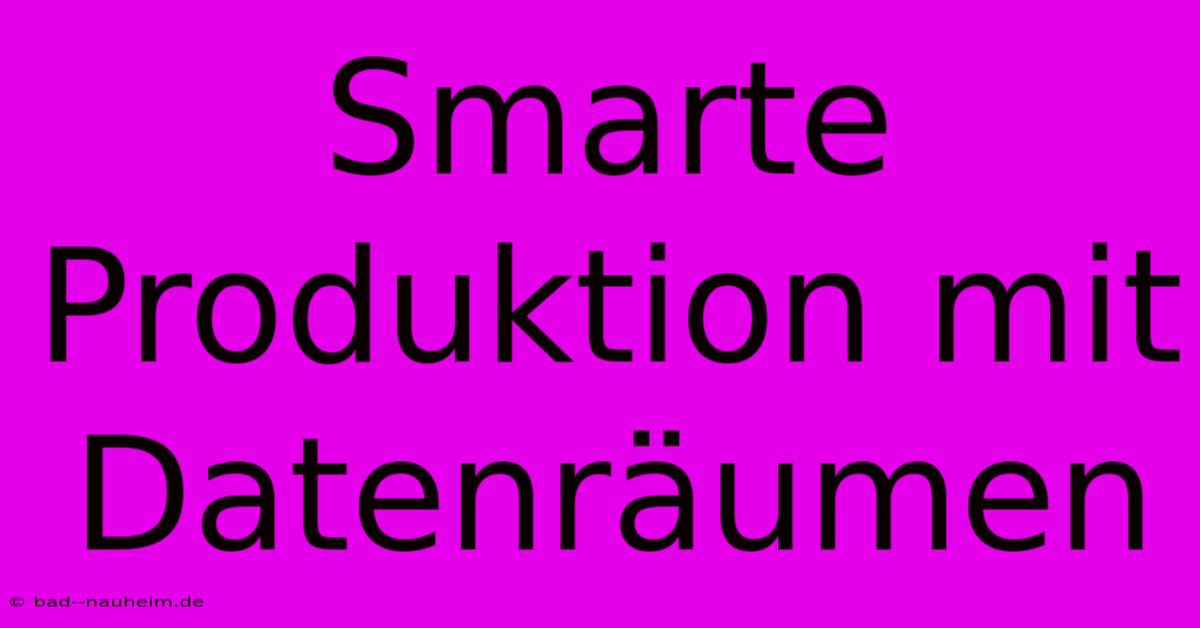Smarte Produktion Mit Datenräumen

Discover more detailed and exciting information on our website. Click the link below to start your adventure: Visit Best Website Smarte Produktion Mit Datenräumen. Don't miss out!
Table of Contents
Smarte Produktion mit Datenräumen: Meine Erfahrungen und Tipps
Hey Leute! Let's talk about smarte Produktion – specifically, how Datenräume can totally revolutionize things. I've been knee-deep in this stuff for years, and let me tell you, it's been a wild ride. Lots of ups, a few downs, and definitely some moments where I wanted to throw my laptop out the window. But hey, that's part of the learning process, right?
Early Days: Chaos and Confusion
My first foray into datengetriebene Produktion was…well, let's just say it was less "smart" and more "utter chaos." I was working with a small manufacturing company, and we were trying to implement a new system. We thought, "Data rooms! Sounds amazing! We'll be so efficient!" Wrong. We ended up with a bunch of siloed data, different systems talking to each other like cats and dogs, and a huge headache. The Datenintegration was a nightmare. Seriously, it felt like trying to solve a Rubik's Cube blindfolded.
We lacked a clear strategy, a solid Datenmanagementplan, and frankly, the right expertise. We underestimated the complexities of Datenanalyse in manufacturing. I spent weeks trying to make sense of all the conflicting information, pulling my hair out. We needed a better understanding of Industrie 4.0 principles and how they apply to our specific needs. It was a costly lesson learned, but a crucial one.
Turning the Tide: Structure and Strategy
The turning point came when we finally decided to get some serious help. We hired a consultant who specialized in digitale Transformation and, boy, did that make a difference! They helped us develop a proper data strategy, focusing on:
- Definierte Datenstrukturen: This was key. We needed to standardize how we collected and stored data.
- Sicherheitsmaßnahmen: Protecting sensitive data is paramount, especially in a datenraum environment. Think data encryption, access control, the whole nine yards.
- Kollaboration: The consultant showed us how to break down the silos and foster collaboration between different departments. Sharing data effectively? That's the gold.
The Implementierung wasn't a walk in the park, it took time and effort. But the results were incredible. We saw significant improvements in efficiency, reduced production times, and a better understanding of our processes. Using the Datenraum for collaborative projects was especially beneficial, accelerating design reviews and approvals.
Practical Tips for Success
If you're thinking about using Datenräume for your smarte Produktion, here's what I'd recommend:
-
Start small: Don't try to do everything at once. Focus on one specific area, gather data intelligently, then gradually expand. This avoids the "big bang" approach and reduces the risk of errors.
-
Invest in training: Your team needs to understand how to use the new systems and interpret the data.
-
Choose the right tools: There are so many different Datenraum Lösungen available; find the one that best suits your specific needs and budget. Don't just grab the shiniest toy; consider scalability and integration capabilities carefully.
-
Focus on data quality: Garbage in, garbage out. Ensure your data is accurate, reliable, and consistent. This sounds obvious, but it's easy to overlook.
-
Don't be afraid to ask for help: If you're struggling, don't hesitate to reach out to experts. This saved my bacon more times than I can count.
The Bottom Line
Implementing a Datenraum for smarte Produktion is a journey, not a destination. It takes planning, patience, and the right tools. But the potential benefits – increased efficiency, reduced costs, better decision-making – are massive. Don’t forget to focus on security and data quality. So buckle up and get ready for the ride!

Thank you for visiting our website wich cover about Smarte Produktion Mit Datenräumen. We hope the information provided has been useful to you. Feel free to contact us if you have any questions or need further assistance. See you next time and dont miss to bookmark.
Featured Posts
-
Film Mittwoch Bis Zur Wahrheit
Nov 21, 2024
-
Film Mittwoch Wahrheit Im Fokus
Nov 21, 2024
-
Comeback 90er Star Auf Netflix
Nov 21, 2024
-
Der Naechste 007 Kandidatenliste
Nov 21, 2024
-
Hoehenretter Erneut In Gruenheide
Nov 21, 2024
